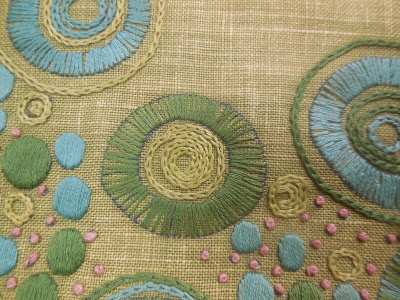Sunday, June 4, 2017
My favorite things 23
I can't remember how old I was when I first realized that you could do embroidery without using somebody else's pattern; certainly past the voting/drinking age. In those olden days, if you wanted to do embroidery you had several choices: you could buy a handkerchief or tablecloth or other article pre-stamped with a pattern, or you could buy a "transfer sheet" of designs that you could iron into your own handkerchief, tablecloth or other article, or you could buy a kit with a pre-stamped pattern and all the embroidery threads you would need to make the project.
I have worked with all three of those business models, and have the finished goods to prove it.
By the time I got married and moved to Europe my embroidery skills were pretty good, and I was enthralled by the wide variety of stitchery kits on sale in stores, things that I had never seen in the States. The design world was all excited about what we now call Mid-Century Modern (or Moderne), a clean, Scandinavian-inspired esthetic that was way less fussy and realistic than the stuff available at home. I think it was on our first trip to London, at Harrod's, that I bought the kit for a green linen pillow with green and turquoise stylized flowers.
Today, I hold kits in disdain, and have announced to every class I ever teach that my life mission is that nobody should ever have to use other people's patterns. But being honest about it, kits have several virtues, especially for hand stitching. You only have to buy just enough fabric and thread to finish the project, rather than hunt about for a fabric store or a thread store, hope you get the right weight of thread for the fabric, hope you can find the colors that go well together, hope you can figure out the right size of needle.
With a kit, there it all is. Hard to argue against it!
I had already bought and made up my fair share of embroidery kits, and by the time I got to this one I had already developed my own approach to kits. Namely, I would start out following the directions, but after I got a feel for the stitches and the design I would usually veer off and finish the project with my own plan. The kit gave me a good comfort level with the materials, and confidence with how the design was progressing, to underpin my rebellion.
I'm not sure how far I followed the directions on this kit; obviously I didn't fill in the big circles as densely as I was supposed to, because you see the stamped pattern lines clearly between the stitches.
The colors have faded in 40+ years; the once rich avocado linen has become a drab olive-beige, the once vivid chartreuse has become a dull mustard-beige, the pink has lost its bite. And in the many years that the pillow sat on my living room couch, it developed stains, holes and threadbare spots. I retired it from active duty many years ago.
But I would never throw it away. It marks an important stage in my own artistic development. I was honing my taste and polishing my technical skills, and acquiring the confidence to abandon the directions. Those satin stitches were pretty damn good, and the french knots held their bulk through years of being sat upon and rubbed against. When they do my lifetime retrospective, they could put this in the first room as "early work."
Subscribe to:
Post Comments (Atom)









Great story. Thanks for sharing it. I am ambivalent about kits - I think they serve to help us hone our individual aesthetic. yes, early work.
ReplyDeleteI would like every quilter to design and make at least ONE quilt of their very own. Ideally this would be beyond even choosing a traditional block and setting and deciding sizes and colors themselves. (But hey, if that truly is as far as they can get, then I want them to GET there!)
ReplyDeleteI have what seems to be a pattern dyslexia, wherein I can barely see the instructions in a pattern, much less read and make sense of it. It's like letters spinning on the page. Weird, as nothing else gets me quite like that. But it's worked to my advantage, as I've never made a quilt from a pattern. If I wanted to make a project look like someone else's, I had to figure out how. It was a good thing to learn.
As to your pillow, I think it's still very pretty, and I want to see it as the center of a medallion quilt!! Of course I specialize in them, so I see many things that way. But just give it a thought... :)
it's too degraded to use in a quilt -- the only possible re-use would be to plonk it down in all its stained, threadbare, hole-y glory on a background support and maybe do some kind of border and display it as repurposed work. I could do that -- or wait for Vivian (age 4 weeks yesterday) to inherit it and do same....
DeleteYour satin stitches are fabulous!
ReplyDeleteI actually avoided kits because they all seemed to feature copious amounts of satin stitch. To me it's the most boring, easy to goober, obvious-when-goobered stitch ever. You're right about the convenience of the supplies though.
Love your "early work". :)
With care I wonder if a little 'wabi sabi' wouldn't be the right approach? I've always appreciated the art of Japanese mending - so artful.
ReplyDelete